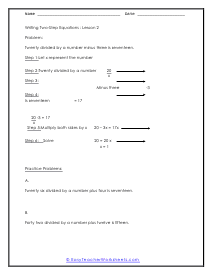Below you will find basic and advanced uses of complex numbers. We will show you how to perform basic mathematical operations with these values. You will also see how to convert these values back to a standard form that is much more recognizable for most students. We will explore how they are affected by absolute value symbols. You will also learn how to chart these in a graphically form that will lead you to developing full scale models.
Complex Number Worksheet Categories
Click any of the images or words below to print out the equation sheets.

Absolute Value of Complex Numbers
We show you how to gauge the distance a value sits from zero on a number line.

Adding and Subtracting Complex Numbers
You need to remember that the imaginary unit is not really a variable. It is the square of negative one.

Graphing These Values
We show you how to model these values in a coordinate system. We quickly learn that we can plot these values much like we can plot real numbers.

Imaginary Units
These are the values that break all the rules. As if rules we have learned in the past do not apply to these values.

Multiplying and Dividing Complex Numbers
We show that multiplying these values are very similar to how you would multiply two binomials. Division when working with these numbers is just rewriting the values in fractional form.

What are Complex Numbers?
For the majority of our math career we work solely with real numbers such as basic integers, decimals, fractions, and even pi. These values can be represented on a number line. Then we looked at the use of imaginary units such i and Pi times i. Now we introduce the concept of complex numbers that basically crash both worlds together. For example, if we used the values 8 and 1.5 and the imaginary unit 2i we could create a complex number in the form of x= 8(2i) + 1.5. Complex numbers make simplification nearly impossible in a lot of instances. One of the things students often overlook is that math is not an exact science and can, at times, be devised for expediency and theory. These types of representations are used in the fields of science and engineer all the time. Theoretical physics often uses all these forms of notation to represent physical phenomenon that they cannot see even with the strongest lens that technology could create. Electric current is often described in a similar way. One of the aspects that is often overlook is that imaginary numbers allow us to create weather forecast models. Those big moving patterns of weather we take for grant on the morning newscasts are all driven by this type of work. Trajectories of many different things, including weather, depend on abstract modelling that is made possible by you guessed it complex numbers. Another application that is currently being explored by many scientists is how to predict behaviors that follow some sort of pattern. Guess what form of math they use when modelling these behaviors?
Complex numbers are the sum of real and imaginary numbers. Real forms are numbers that exist in the numerical system. Positive, negative, rational, irrational, and fraction values are some examples of real numbers. They are denoted as Re ().
Imaginary numbers are values that, when squared, give a negative value. An example of an imaginary number is √-3 and √-5. They are denoted as Im ().
They can be represented by z and are formulated:
Z = a + ib
Where z represents complex numbers, a represents real value, and ib represents an imaginary value. The letter ‘i’ denoted Iota, which represents the value √-1.
The Power of Iota(i)
The iota is used to find a negative number’s square root, such that i2 = -1. The values of I are represented in the table below:
|
Iota (i) |
Value |
|
i |
√-1 |
|
i2 |
-1 |
|
i3 |
-i |
|
i4 |
1 |
|
i4n |
1 |
|
i4n+1 |
i |
|
i4n+2 |
-1 |
|
i4n+3 |
-i |
Using Them With Operations
Complex numbers can undergo arithmetic operations. They can be added, subtracted, multiplied, and divided. All you need to do is apply the arithmetic operation between like terms. That means the real numbers with each other and the imaginary numbers with each other.
Addition
They are added similarly to the addition of natural numbers.
For example, if z1 = a + ib and z2 = c + id, then z1 + z2 = (a + c) + i (b + d).
The properties of addition that these values follow include:
- Commutative Law: States that the sum of two complex numbers will be the same no matter how arranged. That means z1 + z2 = z2 + z1
- Closure Law: States that the sum of two complex numbers should also be a complex number.
- Associative Law: The sum of more than two complex numbers will be the same no matter how they are arranged. That means z1 + (z2 + z3) = (z1 + z2) + z3
Subtraction
The subtraction of complex numbers is done similarly to the subtraction of the natural form.
For example, if z1 = a + ib and z2 = c + id, then z1 - z2 = (a - c) + i (b - d).
Multiplication
Multiplication of complex numbers is different from the multiplication of the natural form.
For example, if z1 = a + ib and z2 = c + id, then z1 x z2 = (ac -bd c) + i (ad + bc).
Division
The division of complex numbers is different from the division we are accustom to. To complete division in these cases, you need to use the reciprocal of the complex number.
For example, if z1 = a + ib and z2 = c + id, then z1 / z2 = (a + ib) x 1 / (c + id) = (a + ib) x (c – id) / (c2 + d2)
Identities
Natural numbers have three algebraic identities. Complex numbers have five:
- (z1 + z2)2 = (z1)2 + (z2)2 + 2 z1 × z2
- (z1 – z2)2 = (z1)2 + (z2)2 – 2 z1 × z2
- (z1)2 – (z2)2 = (z1 + z2) (z1 – z2)
- (z1 + z2)3 = (z1)3 + 3(z1)2 z2 + 3(z2)2 z1 + (z2)3
- (z1 – z2)3 = (z1)3 – 3(z1)2 z2 + 3(z2)2 z1 – (z2)3


